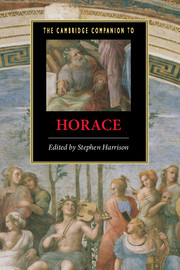Book contents
- Frontmatter
- Introduction
- Part 1: Orientations
- Part 2: Poetic Genres
- Part 3: Poetic Themes
- 12 Philosophy and ethics
- 13 Gods and religion
- 14 Friendship, patronage and Horatian sociopoetics
- 15 Wine and the symposium
- 16 Erotics and gender
- 17 Town and country
- 18 Poetics and literary criticism
- 19 Style and poetic texture
- Part 4: Receptions
- Dateline of works and major political events
- Works cited
- Index
19 - Style and poetic texture
from Part 3: - Poetic Themes
Published online by Cambridge University Press: 28 May 2007
- Frontmatter
- Introduction
- Part 1: Orientations
- Part 2: Poetic Genres
- Part 3: Poetic Themes
- 12 Philosophy and ethics
- 13 Gods and religion
- 14 Friendship, patronage and Horatian sociopoetics
- 15 Wine and the symposium
- 16 Erotics and gender
- 17 Town and country
- 18 Poetics and literary criticism
- 19 Style and poetic texture
- Part 4: Receptions
- Dateline of works and major political events
- Works cited
- Index
Summary
Horace’s carefully crafted poetic style, fundamentally influenced by the Callimachean aesthetics of brevity, elegance and polish, was already recognised as such within a century of his death: a character in Petronius' Satyrica (118.5) refers to Horati curiosa felicitas, 'Horace’s painstaking felicity of expression'. Both this verbal craft and its structural analogue, Horace’s careful construction of his poems, have been well discussed in recent scholarship; his main contribution to Roman poetic language has been seen as the art of careful combination of traditional and innovatory elements, including an admixture of 'unpoetic' and colloquial language, while his brilliant poetic architecture and impressive manipulation of complex Greek lyric metres in the Odes have been a constant subject of study. Though some have played down Horace’s use of imagery, it is clear that it is rich and detailed. Careful scholarly collections of material illuminating Horatian poetic language are readily available, especially in the great commentaries of recent years; in this chapter I would like to try to convey something of Horace’s stylistic and poetic virtuosity in a form accessible to both specialists and non-specialists, by brief close examination of three relatively short poems from the three main literary kinds in which Horace worked: iambus, lyric and hexameter sermo.
- Type
- Chapter
- Information
- The Cambridge Companion to Horace , pp. 262 - 274Publisher: Cambridge University PressPrint publication year: 2007

